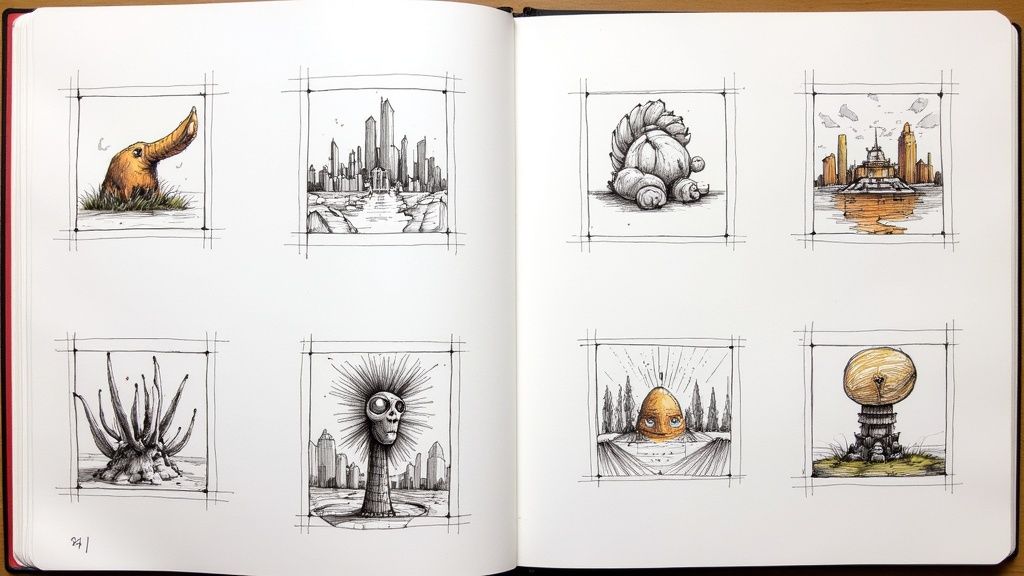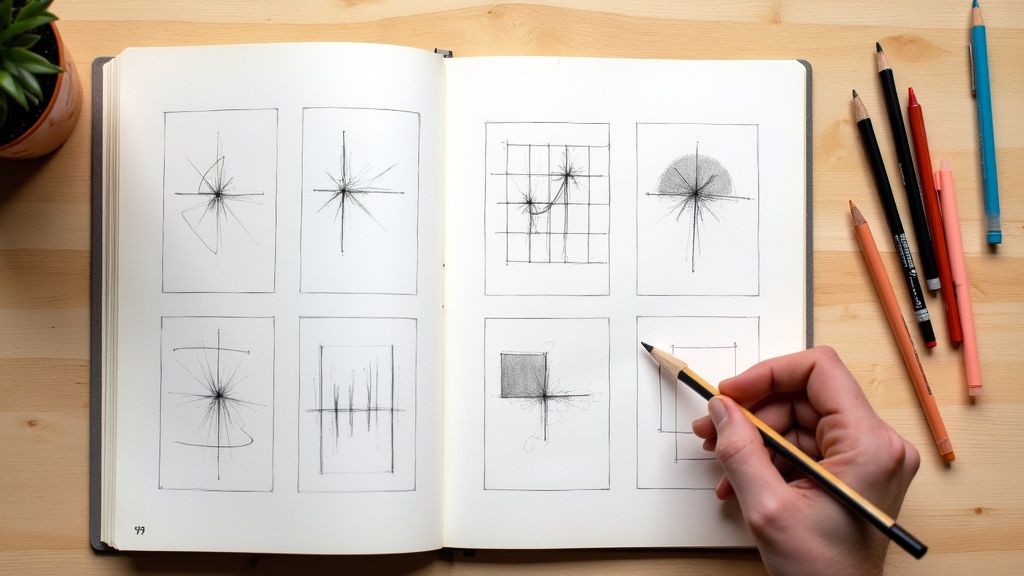Ever stared at a blank page, wanting to create but feeling unsure where to begin? The journey from an aspiring artist to a confident creator starts with a single, simple line. This guide is your first step. We have curated a collection of easy drawings to draw that are specifically designed for beginners, focusing on building foundational skills and boosting your confidence. Forget complex anatomy or daunting perspective rules; these ideas are about having fun while learning.
Each concept in this list utilizes basic shapes you already know, like circles, squares, and lines, to create recognizable and satisfying results. You will learn how to break down subjects like faces, animals, and even vehicles into manageable components. This approach demystifies the drawing process, proving that artistic skill is not an innate talent but a practice that anyone can develop.
Whether your goal is to doodle during a meeting, start a consistent sketchbook habit, or lay the groundwork for more ambitious projects, these simple drawings will show that you can learn to draw. Let's pick up a pencil and turn that blank page into a world of your own making.
1. Stick Figures
Often dismissed as overly simple, the humble stick figure is the undisputed foundation of figure drawing and one of the most essential easy drawings to draw for any beginner. It's a powerful tool for understanding human anatomy, proportions, and movement without getting bogged down in complex details. By using simple lines for the torso, arms, and legs, and a circle for the head, you can quickly represent the human form in countless poses.
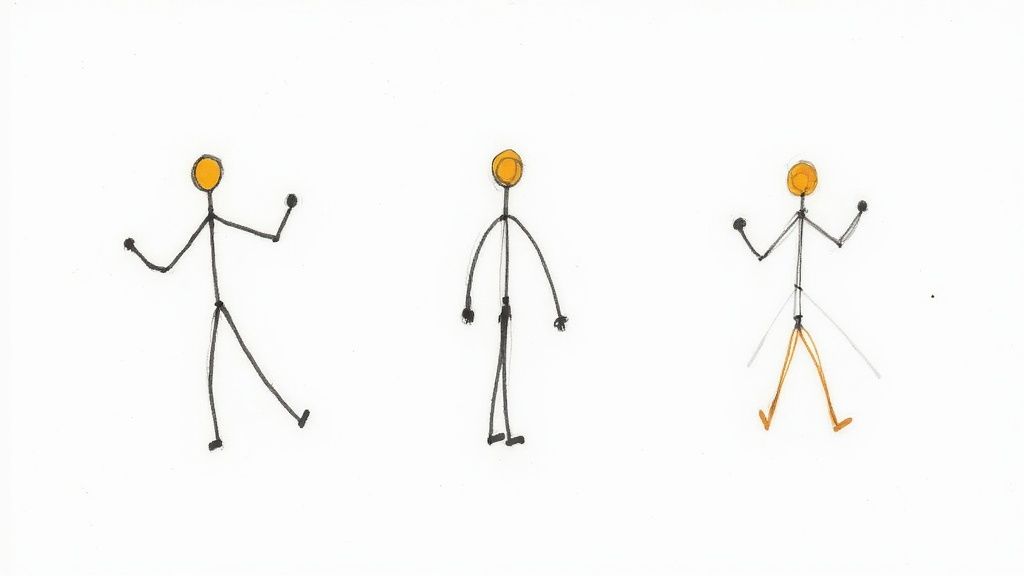
This fundamental approach is used everywhere, from the minimalist yet expressive characters in Randall Munroe's webcomic XKCD to the crucial storyboard sketches that map out entire animated films. Its simplicity is its greatest strength, allowing for rapid ideation and clear communication of action and emotion.
How to Master the Stick Figure
To move beyond static figures, focus on conveying movement and personality. This practice builds a strong foundation for more advanced character art.
- Start with an Action Line: Before drawing the figure, sketch a single, curved line (a "line of action") to represent the main flow of the pose. Build your stick figure around this line to create a more dynamic and natural-looking posture.
- Add Simple Joints: Place small circles where the shoulders, elbows, hips, and knees would be. This helps you visualize how the limbs bend and makes posing your figure much more intuitive.
- Vary Line Weight: Use a slightly thicker line for the torso and thinner lines for the limbs. This subtle change adds a sense of depth and hierarchy to your simple drawing.
- Express with Simplicity: You don't need detailed features to show emotion. Two dots for eyes and a simple curve for a mouth can convey happiness, sadness, or surprise. Tilting the head can also add a layer of personality.
2. Simple Flowers
Drawing simple flowers is a classic entry point for beginners, teaching fundamental skills in creating organic shapes, symmetry, and composition. By starting with a basic circle for the center and arranging petal shapes around it, anyone can quickly sketch recognizable forms like daisies or sunflowers. This exercise is one of the most rewarding easy drawings to draw because it combines simple geometric elements into a beautiful, naturalistic object.
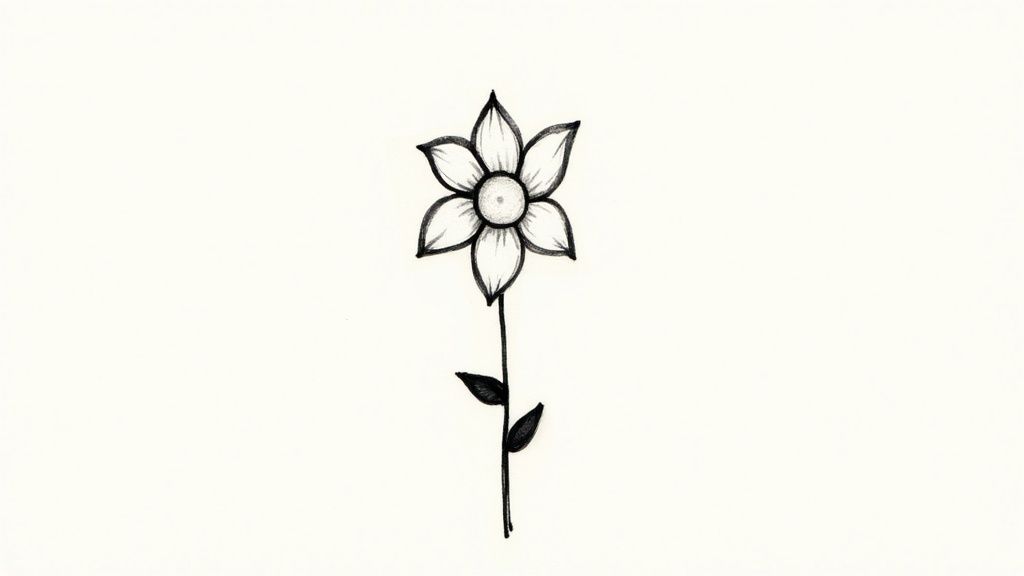
The appeal of this subject is timeless, appearing everywhere from decorative borders on greeting cards and traditional folk art to the foundational sketches used in botanical illustration. Its simplicity allows beginners to build confidence by producing an aesthetically pleasing drawing with minimal effort, making it a perfect stepping stone to more complex subjects. You can explore a wide variety of designs by checking out more drawing ideas for flowers.
How to Master Simple Flowers
To bring your floral sketches to life, focus on adding subtle variations and understanding their basic structure. These techniques will help you move from flat symbols to dynamic and appealing representations of nature.
- Start with a Circular Center: Lightly sketch a circle to serve as the guide for the flower's core. This establishes the central point from which all the petals will radiate.
- Draw Petals as Basic Shapes: Begin by drawing petals as simple overlapping ovals or teardrop shapes around the center. Don't worry about making them perfectly identical.
- Vary Petal Size and Shape: For a more natural and less mechanical look, slightly alter the size and curve of each petal. Overlapping some petals behind others adds a simple yet effective sense of depth.
- Add a Curved Stem and Leaves: A single, gentle C-curve for the stem looks more organic than a straight line. Attach one or two simple leaf shapes to the stem to complete the composition.
3. Basic Houses
Drawing a basic house is a classic entry point for beginners, transforming simple geometric shapes into a recognizable and satisfying structure. It’s an excellent exercise in combining fundamental forms like squares, rectangles, and triangles to create something with dimension and character. By assembling these basic components, you can easily represent a dwelling, which makes it one of the most approachable and easy drawings to draw for aspiring artists of all ages.
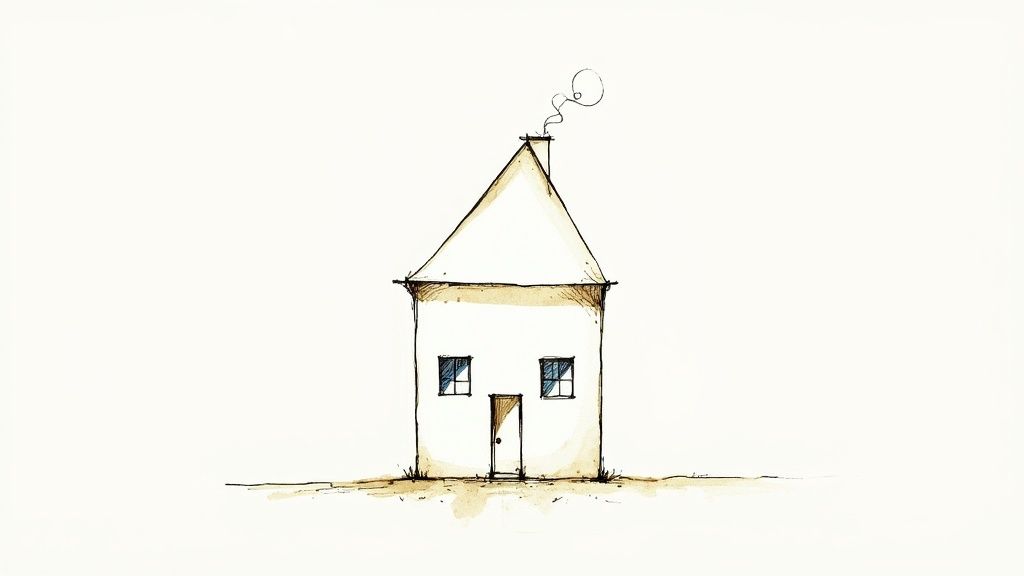
This foundational drawing exercise appears everywhere, from children’s art classes that teach shape recognition to initial architectural concept sketches where quick ideas need to be visualized. The simplicity of a house drawing provides a perfect canvas for learning about symmetry, placement, and adding personal details, serving as a gateway to more complex architectural and environmental art.
How to Master the Basic House
To elevate a simple house drawing, focus on adding details that suggest a story and introduce the basic principles of perspective and depth. This practice builds confidence in constructing scenes.
- Build from Simple Shapes: Start with a large square or rectangle for the main body of the house. Place a triangle directly on top for a simple, pitched roof. This establishes the core structure instantly.
- Establish a Ground Line: Always draw a horizontal line for your house to sit on. This simple step grounds your drawing and prevents it from looking like it's floating, creating a more believable scene.
- Add Symmetrical Features: Place a rectangular door in the bottom center and add square windows on either side. Focusing on symmetry makes the drawing feel balanced and intentional.
- Introduce Simple Details: A small rectangle on the roof can become a chimney, and a few curved lines around the base can represent bushes or a garden path. These small additions bring your simple drawing to life.
4. Cartoon Animals
Cartoon animals are a fantastic entry point for beginners, as they prioritize personality and charm over strict anatomical accuracy. This style involves breaking down complex animal forms into simple, recognizable shapes and exaggerating key features to create an immediate connection with the viewer. By focusing on the essence of an animal, like a cat's pointy ears or a rabbit's long ears and twitching nose, you can create delightful and easy drawings to draw that are full of life.
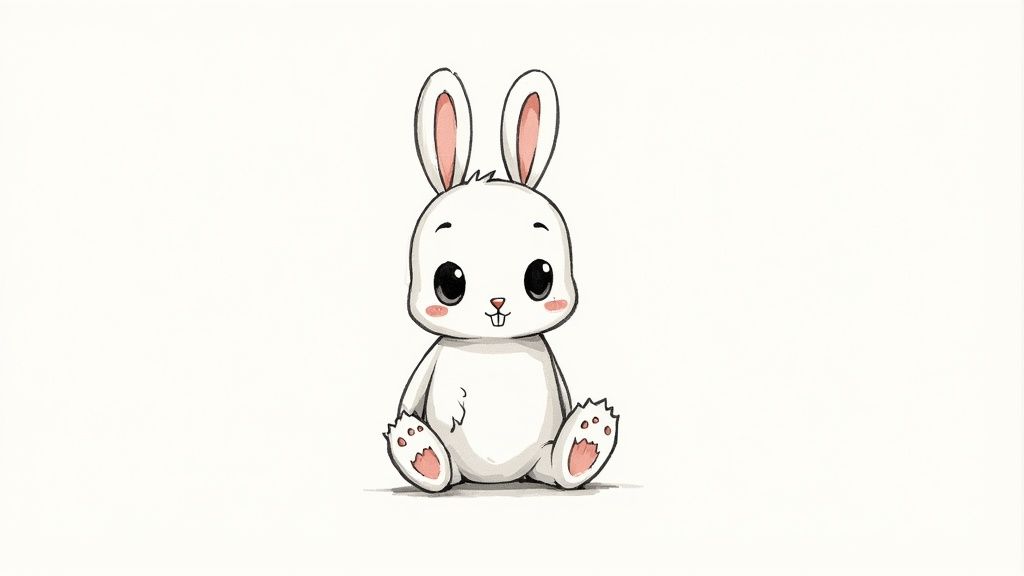
This approachable style has been perfected by legends like Walt Disney, whose characters are built from circles, and Jim Davis, who gave Garfield his iconic look through simple, bold lines. The goal isn't realism; it's expression. This makes cartoon animals a forgiving and incredibly fun subject, perfect for building confidence and exploring character design. For more inspiration, you can learn more about cartoon drawing ideas.
How to Master Cartoon Animals
Drawing compelling cartoon animals is about strategic simplification and emphasizing personality. These techniques will help you capture their unique charm.
- Start with Basic Shapes: Construct your animal's body using fundamental geometric shapes. Use a large oval for the body, a circle for the head, and smaller ovals or triangles for ears and snouts. This provides a solid and proportionate foundation.
- Emphasize Key Features: Identify the animal's most recognizable trait and exaggerate it. For a lion, this might be a huge, fluffy mane; for an elephant, it would be large, floppy ears and a long, flexible trunk.
- Use Large, Expressive Eyes: The eyes are the window to the soul, especially in cartoons. Draw large, round eyes with prominent pupils and highlights to instantly convey emotion, whether it's curiosity, happiness, or surprise.
- Simplify and Suggest Detail: Instead of drawing every strand of fur, use a few curved lines or a soft, zig-zag pattern to suggest texture. A few simple lines can effectively communicate paws, whiskers, or feathers without overcomplicating the drawing.
5. Basic Trees
Drawing basic trees is a fundamental skill for anyone interested in landscapes and one of the most rewarding easy drawings to draw. It teaches artists to capture the essence of organic forms using simple, repeatable shapes. By combining a vertical trunk with a rounded, cloud-like canopy, you can quickly create a recognizable tree that serves as a building block for more complex natural scenes. This approach strips away intricate details like individual leaves, focusing instead on overall shape, proportion, and texture.
This simplified method is a staple in diverse fields, from the calming landscapes of Bob Ross's paintings to the minimalist elegance of traditional Asian ink wash art. It’s also used in environmental education materials and initial landscape architecture sketches, where conveying the idea of nature is more important than photorealistic detail. The power of this technique lies in its accessibility, allowing beginners to add convincing natural elements to their work immediately.
How to Master the Basic Tree
To create trees that feel natural and varied, focus on simple techniques that add depth and character. This practice is key to developing skills for drawing any type of foliage.
- Start with a "Y" Shape: Instead of a single line, begin your trunk with a simple "Y" shape. This immediately establishes a primary branching structure, making the tree look more realistic and less like a lollipop.
- Build a Cloudy Canopy: Use a continuous, bumpy, or scalloped line to create the outline of the leaves. Avoid making it a perfect circle; an irregular, cloud-like shape will appear much more organic.
- Add Simple Trunk Texture: Draw a few parallel, slightly wavy vertical lines along the trunk to suggest bark. You don't need much detail; just a hint of texture is enough to give it a woody feel.
- Vary Your Tree Types: Practice different simple tree shapes. A tall, thin triangle can represent a pine tree, while a wide, sprawling canopy can suggest an oak. Experimenting with these basic silhouettes will expand your visual library.
6. Simple Faces
Drawing a simple face is a gateway to capturing emotion and personality, making it one of the most rewarding easy drawings to draw for beginners. By using a circle or oval for the head and adding basic features, you can explore the fundamentals of facial proportions and expression without the pressure of achieving perfect realism. This foundational skill allows you to communicate a wide range of feelings, from joy to sadness, with just a few well-placed lines.
This minimalist approach is incredibly versatile and powerful. You can see its impact in the universally understood language of emojis, the charming and expressive characters in Charles Schulz's Peanuts comic strip, and countless character design sketches. The simplicity is what makes it so effective; it strips away complexity to focus on the core of human expression.
How to Master Simple Faces
To bring your simple faces to life, concentrate on the placement of features and how minor adjustments can drastically alter the emotion being conveyed. This practice is crucial for developing an intuitive sense of character design.
- Start with a Basic Shape: Begin with a circle or an oval as the base for the head. This serves as your canvas and helps establish the overall structure.
- Use Proportional Guidelines: A key rule of thumb is to place the eyes about halfway down the face. The nose typically sits between the eyes and the mouth, and the mouth is below the nose. These simple guidelines create a balanced look.
- Express with Curves: The mouth is a powerful tool for expression. A simple upward curve can show happiness, a downward curve can indicate sadness, and a straight line can suggest a neutral or serious mood.
- Add Simple Hair: Don't worry about individual strands. Use basic, blocky shapes or simple curved lines on top of the head to frame the face and add personality.
7. Basic Geometric Patterns
Creating basic geometric patterns is an excellent way to practice precision, rhythm, and visual balance, making it one of the most satisfying easy drawings to draw. By using simple shapes like circles, triangles, and squares in repeating arrangements, you can build intricate and beautiful designs from the ground up. This method trains your hand to be steady and your eye to recognize symmetry and structure.
This foundational practice is seen everywhere, from the mesmerizing symmetry of Islamic art to the bold motifs of the Art Deco movement. Even contemporary graphic designers rely on these principles to create compelling visuals. The beauty of geometric patterns is that simple, repeated elements can combine to create something with stunning complexity.
How to Master Basic Geometric Patterns
The key to impressive geometric art is starting with a solid framework and building upon it. This approach develops both precision and creativity, forming a strong base for more complex design work.
- Start with a Grid: Use a ruler to lightly draw a grid of squares or dots on your paper. This underlying structure will act as your guide, ensuring your shapes are aligned and evenly spaced.
- Repeat a Simple Motif: Choose one or two basic shapes, like a square and a triangle, and repeat them in a consistent sequence across your grid. This repetition is the core of pattern design.
- Introduce Symmetry: Focus on creating a balanced design. You can use mirror symmetry (where one half reflects the other) or radial symmetry (where elements radiate from a central point) to create a sense of harmony.
- Build Complexity Gradually: Once you are comfortable with simple repetitions, start layering patterns or combining different grids. For example, you could draw a circular pattern on top of a square grid. Discover more creative approaches to Basic Geometric Patterns on drawinglist.com.
8. Simple Food Items
Drawing simple food items is a fantastic way to practice combining basic geometric shapes to create familiar and appealing subjects. It’s one of the most satisfying easy drawings to draw because it connects art with everyday life. By breaking down items like a slice of pizza into a triangle, a banana into a crescent, or an apple into a modified circle, you learn to see the fundamental forms that make up complex objects.
This approach is widely used in commercial design, from minimalist menu icons to charming illustrations on food packaging. The simplicity allows for clear communication and a universally recognizable style, similar to the work seen in children's educational books or the stylized, delightful paintings of Pop artist Wayne Thiebaud, who celebrated everyday treats in his art.
How to Master Simple Food Items
To make your food drawings look both simple and delicious, focus on capturing the most iconic features of each item without overcomplicating the details.
- Start with the Basic Shape: Identify the core geometric form of the food. An ice cream cone is a triangle and a circle, a slice of watermelon is a wedge, and a donut is a torus (or two concentric circles). Nail this foundational shape first.
- Add Characteristic Details Sparingly: You don't need every seed on a strawberry. Add just enough detail to make it recognizable: a few pepperoni circles on a pizza slice, a stem and leaf on an apple, or the curved lines on a banana peel.
- Use Simple Lines for Texture: Suggest texture rather than drawing it perfectly. A few wavy lines can represent the drippy edge of cheese on pizza, while small dots can imply the texture of a cookie or bread.
- Consider the Most Recognizable Angle: Draw a burger from the side to show its layers, a pizza from the top-down or as a slice, and a cupcake from a three-quarters view to showcase the frosting and wrapper. Choose the angle that best tells the food's story.
9. Basic Vehicles
Drawing basic vehicles is a fantastic exercise in combining simple geometric shapes to create recognizable and functional objects. From cars and trucks to airplanes, these subjects are perfect easy drawings to draw because they are built from fundamental forms like rectangles, circles, and triangles. This approach allows beginners to practice perspective and proportion in a controlled, structured way without being overwhelmed by organic curves.
This method of simplifying complex machinery is essential in many professional fields. It's used to create clear diagrams in technical manuals, engaging illustrations in children's educational books, and straightforward visuals for traffic safety materials. By focusing on the core shapes, you can effectively communicate the form and function of a vehicle with minimal detail.
How to Master Basic Vehicles
The key to drawing compelling vehicles is to start with a solid foundation of shapes and then add defining details. This practice helps build an understanding of how mechanical objects are constructed.
- Start with a Boxy Body: Begin with a simple rectangle or a combination of two rectangles to create the main body and cabin of the car or truck. This establishes the overall size and basic perspective.
- Add Circular Wheels: Place two circles at the bottom of the body to represent the wheels. Pay attention to their placement to make the vehicle look balanced and stable. For a side view, one wheel will be near the front and one near the back.
- Define Windows and Doors: Use smaller squares and rectangles inside the main body to sketch out the windows and doors. This immediately adds realism and a sense of scale to your drawing.
- Include Key Details: Add small, simple features that define the vehicle. A couple of small circles for headlights, a rectangle for the grille, and a small line for a door handle can transform a generic box into a recognizable car.
9 Easy Drawing Types Comparison
Item | Implementation Complexity | Resource Requirements | Expected Outcomes | Ideal Use Cases | Key Advantages |
|---|---|---|---|---|---|
Stick Figures | Very low | Minimal (paper, pen) | Basic human forms, storytelling | Comics, storyboards, beginner drawing | Quick, easy, universally understood |
Simple Flowers | Low | Minimal | Basic symmetry and organic shapes | Greeting cards, children’s books | Teaches symmetry, natural designs |
Basic Houses | Low to moderate | Minimal | Intro to geometry and perspective | Architecture sketches, children’s art | Builds spatial skills, customizable |
Cartoon Animals | Moderate | Minimal | Stylized animals, character design | Animation, children’s books | Engages creativity, expressive |
Basic Trees | Low | Minimal | Organic forms, landscape elements | Environmental art, landscape sketches | Versatile, good for natural forms |
Simple Faces | Low | Minimal | Facial proportions, emotional expressions | Emojis, educational illustrations | Expressive, teaches proportions |
Basic Geometric Patterns | Moderate | Minimal | Precision, rhythm, pattern creation | Textile design, graphic art | Develops precision, meditative |
Simple Food Items | Low | Minimal | Recognizable objects, basic shapes | Menus, packaging, kids’ materials | Relatable, builds confidence |
Basic Vehicles | Moderate | Minimal | Mechanical understanding, spatial skills | Children’s education, technical manuals | Combines shapes, technical foundation |
Your Creative Journey Starts Now
You’ve just navigated a curated collection of foundational drawing ideas, from the structural simplicity of stick figures to the organic charm of basic flowers. The journey through these nine accessible subjects proves a powerful truth: art is approachable for everyone. Each sketch you’ve attempted, whether a whimsical cartoon animal or a structured geometric pattern, has served a purpose far greater than just filling a page.
These exercises are the fundamental vocabulary of visual art. Mastering the basic house helps you understand perspective. Doodling simple food items hones your ability to see and replicate shapes and textures in everyday objects. Every one of these easy drawings to draw is a deliberate step toward building your creative confidence and technical skill. The true value isn't in creating a single perfect piece, but in the consistent act of creation itself.
From Practice to Passion
The most important takeaway from this guide is the power of consistent practice. The initial awkwardness of drawing a simple face or a basic vehicle quickly fades with repetition. Your lines become more confident, your understanding of form deepens, and your unique style begins to emerge.
Think of your sketchbook not as a gallery for finished masterpieces, but as a private gym for your creative muscles.
- Embrace Imperfection: Every "mistake" is a learning opportunity. Don't erase it; learn from it and draw the next one better.
- Focus on Volume: Aim to fill a page a day. The quantity of your practice will naturally lead to an increase in quality over time.
- Build on the Basics: Once you master a simple flower, try a bouquet. After drawing a basic car, try designing your own. Each easy drawing is a launchpad for a more complex creation.
Your Actionable Next Steps
To keep your momentum going, it's crucial to turn inspiration into action. Don't let this newfound motivation fade. Instead, channel it into a tangible routine that will foster growth and keep you excited about your artistic development.
- Choose a "Focus Subject" for the Week: Dedicate the next seven days to one of the topics from our list. Draw as many variations of simple trees or cartoon animals as you can. This deep dive will accelerate your learning significantly.
- Start a "Daily Doodle" Challenge: Set aside just ten minutes each day to complete one simple drawing. This low-pressure commitment makes it easy to stay consistent and build a powerful creative habit.
- Share Your Work (If You're Comfortable): Sharing your progress with a friend or an online community can provide encouragement and valuable feedback, turning a solitary hobby into a shared journey.
The path to becoming a skilled artist is paved with small, deliberate steps. By consistently practicing these easy drawings to draw, you are not just learning to replicate images; you are learning the universal language of visual expression. This foundation will empower you to bring your own unique ideas to life, transforming a blank page from an intimidating void into a field of infinite possibility. Keep your pencil moving, stay curious, and celebrate every small victory along the way. Your creative journey truly starts now.
Feeling inspired but not sure what to draw next? The Drawing List ideas generator provides endless, unique prompts tailored to your skill level. Visit Drawing List to discover your next creative challenge and keep your artistic momentum flowing.
